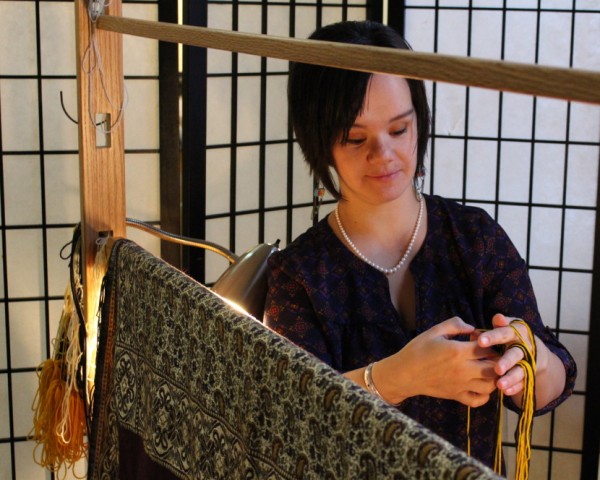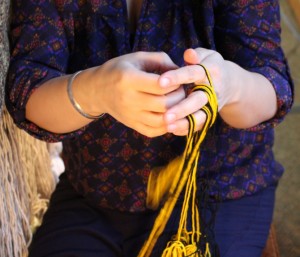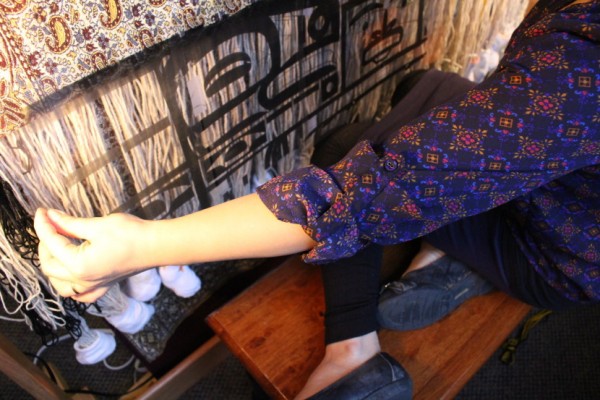The Portland Art Museum in Oregon has commissioned a Tlingit Chilkat robe from a Juneau weaver — adding a fourth generation to a lineage of weaving students and teachers.
In a shop downtown, Lily Hope is weaving her first Chilkat blanket.

She sits in front of a 5-foot-long wooden loom carved by her father. It’s the second week of a year-long project, but the Chilkat robe is already taking shape. Chunky stripes of black and yellow.
Hope weaves across the loom. A motion she describes as jumping jacks for her fingers. She says this is the first time in years she’s had regular hours away from her children.
“I don’t know about other moms who’ve gone back to work, but it’s pretty emotionally challenging,” Hope says. “Ultimately it’s gratifying, satisfying to be here to weave. But it’s a constant opportunity cost of what am I giving up to be able to weave?”
Hope says Chilkat blankets are one of the most prestigious ceremonial dance robes.

The warp — or the set of vertical yarns in the weaving project — hangs free, vertically on the loom. This warp is made of merino wool twined with strips of cedar. At the bottom, several strings are clumped together in a row of tiny socks. Actually, Hope’s kids socks. And her own from when she was a kid.
“I love having all of the generations, you know, sitting here. Hanging out. Little feet hanging out,” she says.
When Hope was about 6 years old, she remembers her mother learned to weave from Jennie Thlanaut.
“I don’t know if you’ve been in an elderly Native household, but it smelled like seal oil or like fibers. If I could go back in time and smell that again, I know that’d be so vivid in my mind.”
Her mom tried to teach her, but she says she thought it was dull as a teenager. In her 20s, she picked up Ravenstail weaving and later, Chilkat.
“It was interesting to return to it and to feel that similar time passing but not be bored by it,” Hope says.
The Portland Art Museum has Chilkat robes from three generations of weavers, including Hope’s mom–Clarissa Rizal. Museum curator Deana Dartt says the blankets will be part of a traveling exhibit next year called The Art of Resilience: The Continuum of Tlingit Art.
“In showing the continuum, in this big exhibition, it made sense to me to commission a robe by one of Clarissa’s students and extend that genealogy to a fourth generation,” Dartt said.
That fourth generation being Hope. Dartt thinks no other museum in the country has a lineage of Chilkat robes like this. But she says the blankets don’t just belong to the museum. They belong to the tribes, too. That’s why the museum loans the items for ceremonial events.
“One of the things we’re really working on here, at the Portland Art Museum, is having those important objects be a part of the living culture.”
Dartt says she’d like to see Hope and her mom’s robe danced together someday.
Back at the loom, Hope’s finishing up the border on the Chilkat robe. Soon, she’ll start the process of weaving Tlingit moieties in the design.
“So we’ve got the Raven teaching the Eagle, teaching the Raven, teaching the Raven,” she says. “So it’s a lineage robe honoring our teachers.”
Hope isn’t posting photos on Facebook or Instagram of her progress with the weaving. She’s keeping with tradition. The blanket won’t be seen by the masses until it’s finished.

Hope says she won’t weave when she’s angry. When she’s at the loom, she only weaves with a feeling of gratitude.
“How lucky am I to sit here in front of this piece, in front of this ancient art form and have my hands in this warp and be like, wow!” Hope says. “It’s a little overwhelming and kind of leaks into the rest of life to have gratitude to be able to do this but gratitude to go home and see my kids.”
At first she was afraid to spend the thousand hours it takes to weave the Chilkat blanket alone.
“What do you do with yourself all day with your thoughts? It hasn’t scared me as much as I thought it would. It’s not that scary.”
The Chilkat robes will travel with the exhibit around the country next year. Then possibly to Paris and back to Juneau in 2019 for a 10,000-square-foot exhibition.




